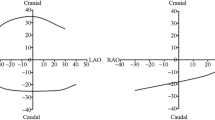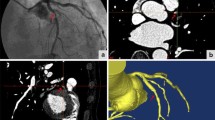Abstract
The purpose of this study was to evaluate the accuracy of dual-axis rotational coronary angiography (DARCA) for coronary lesion assessment by directly comparing with intravascular ultrasound (IVUS). From October 2014 to December 2015, 40 patients (58 lesions) who had undergone both DARCA and IVUS were included in the image analysis. The minimum lumen diameter (MLD), lesion length, reference vessel diameter (RVD) and percent diameter stenosis at the same lesion, were identified and assessed. Significant correlation with IVUS was found for DARCA in either lesion length (r = 0.90, P < 0.001) or RVD (r = 0.81, P < 0.001) comparison. DARCA had fair correlation with IVUS for both MLD (r = 0.65, P < 0.001) and diameter stenosis (r = 0.48, P < 0.001). From the Bland–Altman plots, there was a good agreement between DARCA and IVUS regarding MLD (mean difference: −0.23 mm, 95 % limits of agreement: −0.96 to 0.50 mm) and RVD (mean difference: −0.15 mm, 95 % limits of agreement: −0.85 to 0.55 mm), while lesser agreement was found on lesion length (mean difference: −3.39 mm, 95 % limits of agreement: −12.63 to 5.85 mm) and diameter stenosis (mean difference: 4.82 %, 95 % limits of agreement: −17.05 to 26.68 %). There is an adequate correlation and agreement between DARCA and IVUS in coronary lesion assessment.




Similar content being viewed by others
References
Fihn SD, Blankenship JC, Alexander KP, Bittl JA, Byrne JG, Fletcher BJ, Fonarow GC, Lange RA, Levine GN, Maddox TM, Naidu SS, Ohman EM, Smith PK (2014) 2014 ACC/AHA/AATS/PCNA/SCAI/STS focused update of the guideline for the diagnosis and management of patients with stable ischemic heart disease: a report of the American College of Cardiology/American Heart Association Task Force on Practice Guidelines, and the American Association for Thoracic Surgery, Preventive Cardiovascular Nurses Association, Society for Cardiovascular Angiography and Interventions, and Society of Thoracic Surgeons. J Am Coll Cardiol 64:1929–1949. doi:10.1016/j.jacc.2014.07.017
Vlodaver Z, Frech R, Van Tassel RA, Edwards JE (1973) Correlation of the antemortem coronary arteriogram and the postmortem specimen. Circulation 47:162–169
Schwartz JN, Kong Y, Hackel DB, Bartel AG (1975) Comparison of angiographic and postmortem findings in patients with coronary artery disease. Am J Cardiol 36:174–178
De Scheerder I, De Man F, Herregods MC, Wilczek K, Barrios L, Raymenants E, Desmet W, De Geest H, Piessens J (1994) Intravascular ultrasound versus angiography for measurement of luminal diameters in normal and diseased coronary arteries. Am Heart J 127:243–251
Mintz GS, Painter JA, Pichard AD, Kent KM, Satler LF, Popma JJ, Chuang YC, Bucher TA, Sokolowicz LE, Leon MB (1995) Atherosclerosis in angiographically “normal” coronary artery reference segments: an intravascular ultrasound study with clinical correlations. J Am Coll Cardiol 25:1479–1485
Koskinas KC, Ughi GJ, Windecker S, Tearney GJ, Raber L (2016) Intracoronary imaging of coronary atherosclerosis: validation for diagnosis, prognosis and treatment. Eur Heart J 37:524–535. doi:10.1093/eurheartj/ehv642
Tommasini G, Camerini A, Gatti A, Derchi G, Bruzzone A, Vecchio C (1998) Panoramic coronary angiography. J Am Coll Cardiol 31:871–877. doi:10.1016/S0735-1097(98)00014-X
Maddux JT, Wink O, Messenger JC, Groves BM, Liao R, Strzelczyk J, Chen SY, Carroll JD (2004) Randomized study of the safety and clinical utility of rotational angiography versus standard angiography in the diagnosis of coronary artery disease. Catheter Cardiovasc Interv 62:167–174. doi:10.1002/ccd.20036
Raman SV, Morford R, Neff M, Attar TT, Kukielka G, Magorien RD, Bush CA (2004) Rotational X-ray coronary angiography. Catheter Cardiovasc Interv 63:201–207. doi:10.1002/ccd.20130
Garcia JA, Chen SY, Messenger JC, Casserly IP, Hansgen A, Wink O, Movassaghi B, Klein AJ, Carroll JD (2007) Initial clinical experience of selective coronary angiography using one prolonged injection and a 180 degrees rotational trajectory. Catheter Cardiovasc Interv 70:190–196. doi:10.1002/ccd.21054
Garcia JA, Agostoni P, Green NE, Maddux JT, Chen SY, Messenger JC, Casserly IP, Hansgen A, Wink O, Movassaghi B, Groves BM, Van Den Heuvel P, Verheye S, Van Langenhove G, Vermeersch P, Van den Branden F, Yeghiazarians Y, Michaels AD, Carroll JD (2009) Rotational versus standard coronary angiography: an image content analysis. Catheter Cardiovasc Interv 73:753–761. doi:10.1002/ccd.21918
Empen K, Kuon E, Hummel A, Gebauer C, Dorr M, Konemann R, Hoffmann W, Staudt A, Weitmann K, Reffelmann T, Felix SB (2010) Comparison of rotational with conventional coronary angiography. Am Heart J 160:552–563. doi:10.1016/j.ahj.2010.06.011
Hudson PA, Klein AJ, Kim MS, Wink O, Hansgen A, Casserly IP, Messenger JC, James Chen SY, Carroll JD, Garcia JA (2010) A novel dual-axis rotational coronary angiography evaluation of coronary artery disease–case presentation and review. Clin Cardiol 33:E16–E19. doi:10.1002/clc.20651
Klein AJ, Garcia JA, Hudson PA, Kim MS, Messenger JC, Casserly IP, Wink O, Hattler B, Tsai TT, Chen SY, Hansgen A, Carroll JD (2011) Safety and efficacy of dual-axis rotational coronary angiography versus standard coronary angiography. Catheter Cardiovasc Interv 77:820–827. doi:10.1002/ccd.22804
Gomez-Menchero AE, Diaz JF, Sanchez-Gonzalez C, Cardenal R, Sanghvi AB, Roa-Garrido J, Rodriguez-Lopez JL (2012) Comparison of dual-axis rotational coronary angiography (XPERSWING) versus conventional technique in routine practice. Rev Esp Cardiol (Engl Ed) 65:434–439. doi:10.1016/j.recesp.2011.12.014
Grech M, Debono J, Xuereb RG, Fenech A, Grech V (2012) A comparison between dual axis rotational coronary angiography and conventional coronary angiography. Catheter Cardiovasc Interv 80:576–580. doi:10.1002/ccd.23415
Liu HL, Jin ZG, Yang SL, Luo JP, Ma DX, Liu Y, Han W (2012) Randomized study on the safety and efficacy of dual-axis rotational versus standard coronary angiography in the Chinese population. Chin Med J (Engl) 125:1016–1022. doi:10.3760/cma.j.issn.0366-6999.2012.06.011
Farshid A, Chandrasekhar J, McLean D (2014) Benefits of dual-axis rotational coronary angiography in routine clinical practice. Heart Vessels 29:199–205. doi:10.1007/s00380-013-0349-7
Giuberti RS, Caixeta A, Carvalho AC, Soares MM, Abreu-Silva EO, Pestana JO, Silva Junior HT, Vaz ML, Genereux P, Fernandes RW (2014) A randomized trial comparing dual axis rotational versus conventional coronary angiography in a population with a high prevalence of coronary artery disease. J Interv Cardiol 27:456–464. doi:10.1111/joic.12148
Mintz GS, Nissen SE, Anderson WD, Bailey SR, Erbel R, Fitzgerald PJ, Pinto FJ, Rosenfield K, Siegel RJ, Tuzcu EM, Yock PG (2001) American College of Cardiology Clinical Expert Consensus Document on Standards for Acquisition, Measurement and Reporting of Intravascular Ultrasound Studies (IVUS). A report of the American College of Cardiology Task Force on Clinical Expert Consensus Documents. J Am Coll Cardiol 37:1478–1492. doi:10.1016/S0735-1097(01)01175-5
Bland JM, Altman DG (1995) Calculating correlation coefficients with repeated observations: Part 2–correlation between subjects. BMJ 310(6980):633
Unzue Vallejo L, Delcan Dominguez JL, Alegria Barrero A, Medina Peralta J, Rodriguez Rodrigo FJ, Rodriguez-Lopez JL (2013) Coronary lesions quantification with dual-axis rotational coronary angiography. Cardiovasc Revasc Med 14:37–40. doi:10.1016/j.carrev.2012.11.001
Chae JS, Brisken AF, Maurer G, Siegel RJ (1992) Geometric accuracy of intravascular ultrasound imaging. J Am Soc Echocardiogr 5:577–587
von Birgelen C, Kutryk MJ, Gil R, Ozaki Y, Di Mario C, Roelandt JR, de Feyter PJ, Serruys PW (1996) Quantification of the minimal luminal cross-sectional area after coronary stenting by two- and three-dimensional intravascular ultrasound versus edge detection and videodensitometry. Am J Cardiol 78:520–525
Kubo T, Akasaka T, Shite J, Suzuki T, Uemura S, Yu B, Kozuma K, Kitabata H, Shinke T, Habara M, Saito Y, Hou J, Suzuki N, Zhang S (2013) OCT compared with IVUS in a coronary lesion assessment: the OPUS-CLASS study. JACC Cardiovasc Imaging 6:1095–1104. doi:10.1016/j.jcmg.2013.04.014
Morris PD, Taylor J, Boutong S, Brett S, Louis A, Heppenstall J, Morton AC, Gunn JP (2016) When is rotational angiography superior to conventional single-plane angiography for planning coronary angioplasty? Catheter Cardiovasc Interv 87:E104–E112. doi:10.1002/ccd.26032
Liu H, Jin Z, Deng Y, Jing L (2014) Dual-axis rotational coronary angiography can reduce peak skin dose and scattered dose: a phantom study. J Appl Clin Med Phys 15:4805. doi:10.1120/jacmp.v15i4.4805
Acknowledgments
We gratefully thank the following people: Professor Manesh R. Patel and Lawrence E. Crawford (Division of Cardiology, Duke University Health System, Durham, NC, USA), as well as Professor Yang Wang (Medical Research & Biometrics Center, National Center for Cardiovascular Disease, Beijing, China), for their kind instructions for this article.
Author information
Authors and Affiliations
Corresponding author
Ethics declarations
Conflict of interest
None.
Rights and permissions
About this article
Cite this article
Jin, Zg., Zhang, Zq., Jing, Lm. et al. Correlation between dual-axis rotational coronary angiography and intravascular ultrasound in a coronary lesion assessment. Int J Cardiovasc Imaging 33, 153–160 (2017). https://doi.org/10.1007/s10554-016-0999-5
Received:
Accepted:
Published:
Issue Date:
DOI: https://doi.org/10.1007/s10554-016-0999-5




